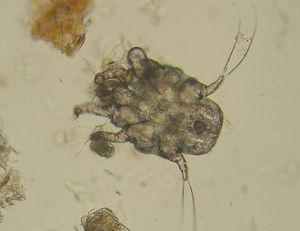The ear mite, Otodectes cynotis, is pale and — as outlined by IPM North Carolina — only measures between 0.3 mm (males) and 0.5 mm (females). Larvae are no bigger than 0.2 mm. Cats are more commonly infested with ear mites than dogs. Now what?
What are the odds of an ear mite infestation?
When investigating cat ear mite symptoms, it was discovered that approximately 20.2 percent to 28.4 percent of cats were hosts to Otodectes cynotis. Long-haired cats in particular have a high risk of infection, with an estimated 75 percent of animals considered to be affected.
Topical symptoms and their causes
There are several telltale signs that alert the car fancier to the presence of the pests.
- Reddish wax buildup: In the course of the infestation, ear mites cause some damage to the skin lining the ear canal. As a result, the production of ear wax increases. Purdue University notes that when mixed with the cat’s blood, the wax invites the presence of bacteria. This results in bacterial infections. If the earwax is left to dry at the outer edges of the ear, it becomes a noticeable blackish debris that crumbles when touched.
- Absence of scabbed skin: Notroedres catis identifies the scabies mite that digs into the cat’s skin and lives there. Michigan State University highlights that this mite produces mange symptoms — occasionally around the ears — but should not be mistaken for the external damage caused by a scratching cat.
- Hair loss on and around ears: Excessive scratching by the host animal leads to scarring of the skin and subsequent hair loss. It is among the classic ear mite symptoms in cats.
- Noticeable smell: The interior of a cat’s ears usually does not have much of a smell. When investigating the smell of a cat’s ears when reddish wax buildup is present, the odor is noticeably foul.
- Visible pus: In the case of heavy infestations that remain untreated for prolonged periods of time, the combination of bacterial infection and the animal’s scratching results in the creation of wounds and eventually the formation of pus. At this point there is a danger that continued lack of treatment results in a damaged eardrum.
Behavioral changes and their causes
Mite-caused damage to the auditory canal — and subsequent bacterial influx — causes itching in the ear area. In an attempt to dislodge the mites, the cat scratches to the point of drawing blood. In another attempt to remove the bothersome mites, affected cats will shake their heads to dislodge the pests. This is partially successful and propels mites into nature, where other hosts animals pick them up.
Also note any ear rubbing; it is common for cats to transfer their scents onto the furniture in the home. When the behavior becomes excessive and focuses primarily on the ear area, there is a good chance that the pet is attempting to relieve the itch of ear mites. Confirm these symptoms by having the veterinarian take a swab of the animal’s earwax. When examined under the microscope, the presence of mites can be confirmed quite easily. Your vet will then be able to prescribe a treatment for your cat.
Sources
IPM North Carolina; “Ear Mite”
Purdue University; “Common Cat Diseases and Health Problems”
Michigan State University; “Mites and Ticks”






